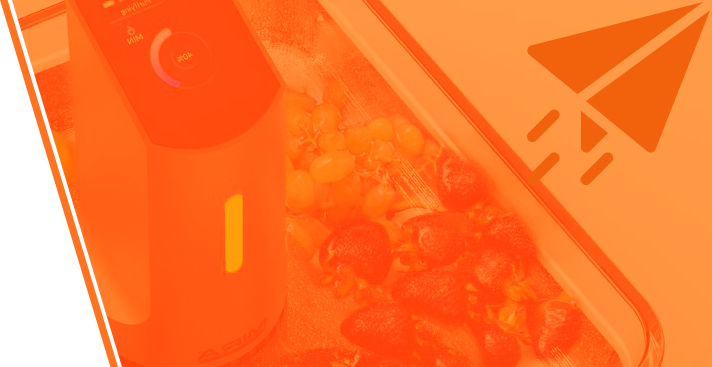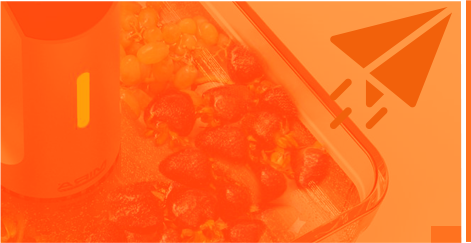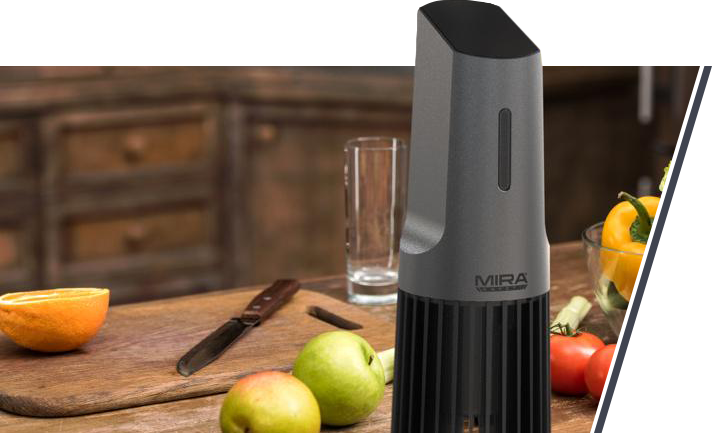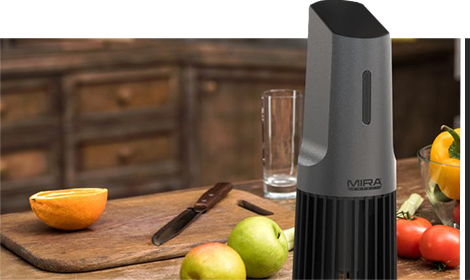In the world of foodborne illness, there is a single set of viruses that makes up the majority of contamination in the food system. When people get "food poisoning," there is an excellent chance that they have crossed paths with one of the noroviruses.
The number of foodborne illness outbreaks in the US per year is staggering. There are approximately 800 foodborne illness outbreaks per year! That is not the number of cases but the amount of outbreaks, and as you will see, a Norovirus outbreak can spread over several states, with each state having an outbreak within!
Our food travels fast in this modern age, and with it, foodborne viruses travel, too!
I am sure that norovirus has run through your family at one time or another. You might not have even been aware that you were dealing with norovirus. However, the symptoms of Norovirus are pretty straightforward.
Symptoms of Norovirus come on quickly and usually unexpectedly. Incubation takes between 12-48 hours.
-

Nausea
-

Vomiting
-

Stomach Cramps
-

Diarrhea
-

Low-Grade Fever
-

Muscle Pain
Though norovirus is a challenging illness that takes everything out of you, it is usually all over in a few days. Of course, it is a nightmare for several days, and it's tough to watch a loved one suffer from such a virus.
Being so highly contagious, it is frankly impossible to avoid if this virus gets into your home. So, it would be best if you stopped the virus long before it gets into your family's body. That all comes down to the food you consume, personal hygiene, and how you clean the food you eat at home.
Norovirus is so common that we had massive outbreaks only weeks ago!
Table of Contents
-
01
Recent Outbreaks of Norovirus
-
02
Norovirus in the Food and Agricultural Systems
-
03
How to Clean Your Food of Norovirus
-
04
Using the DTX-1 to Kill Norovirus and Clean Fruits, Vegetables and Meats
-
05
What Foods Need to Be Cleaned?
-
06
Conclusion
What Causes Listeriosis?
Since foodborne illnesses are so common, an outbreak is almost always being investigated. We will list some of the most common and recent notable outbreaks of norovirus in the United States.

(Image source: Image courtesy of eLife Sciences)
Current
We recently experienced a multi-state outbreak of Norovirus linked to raw oysters from Texas. On December 15th, 2022, 211 cases of norovirus were reported and linked to these raw oysters.
The cases were reported from 8 different states, and at the writing of this article, the investigation is still ongoing. Thankfully the outbreak was traced back to the oysters in Texas, so restaurants and consumers could cook or trash these foods before getting sick.
Norovirus also likes to show up on cruise ships. We have seen massive Norovirus outbreaks run through vacationers trapped on cruise ships. These cases originate from the food served on the boats, or spread by people who board the vessel with the illness.
These outbreaks make headline news because this virus has the propensity to spread rapidly, and people's vacations are ruined.
2019 Royal Caribbean's Oasis on the Seas, holding 9000 passengers, had to head back to port following a massive norovirus outbreak. The illness affected 300 people on the cruise liner, which had to cut its trip short.

The cruise ship industry has suffered greatly from these outbreaks because people have become increasingly wary of cruise ship vacations. The outbreak of a foodborne illness like norovirus can result in profound suffering on the high seas. No one wants a vacation to end on a rocking ship with symptoms like vomiting and diarrhea.
2021 Britain Norovirus Outbreaks Spiked, and the brutal virus was infecting people at a rate 3x higher than in the five years previous! This particular collection of cases was never linked to one specific food but the alarming number of cases compared to previous years got a lot of attention.
This spike was a devastating blow to the UK health system as they were fresh off 2020 and the stresses of the COVID-19 pandemic.
Norovirus in the Food and Agricultural Systems
Contamination can occur at every food production, distribution, and preparation level. This occurrence potential is why safe practices are so important.
Norovirus in Agriculture
As unsettling as this might sound, the agricultural environment can often be exposed to fecal contamination. This type of contamination is common in agricultural settings because of its proximity to livestock and wild animals that come to these areas to eat.

Fecal contamination is at the root of the majority of norovirus outbreaks. You have probably not considered fecal contamination when you look over the produce section at your local supermarket or farmers market.
Water is always moving. When it rains, water rushes over everything. Puddles and pools form, and some bodies of water overflow. All of this flowing water can have elements of contamination from wildlife or livestock. When this water contains fecal contamination from animals and runoff, washes, and pools in agricultural areas, it infects anything growing there.
Of course, farmers wash produce, and consumers do, too. Sometimes, you need a little more than a simple rinse to clean produce and remove dangerous pathogens like norovirus.
Outbreaks of norovirus are increasing because families are eating more fresh produce than ever before. Unwashed fresh produce often hosts several pathogens, so having a high-quality cleaning process at home will make a big difference.
Norovirus in Food Service
Personal hygiene practices and cleaning foods properly ensure that a food service operation can serve its customers and keep them safe from norovirus. Food service workers are far better trained in this day and age on things like proper handwashing, which is key to preventing all forms of foodborne illness.
Poor personal hygiene practices are a massive cause of norovirus outbreaks in the food industry. Improper handwashing after using the bathroom can spread norovirus quickly to the staff or the diners because it is so contagious.

Other things like managing rubber gloves, changing aprons often, and never taking aprons into the bathroom go a long way in preventing a norovirus outbreak. In some restaurants, these things are trained; in others, they are not.
However, in food service, you also have to clean produce and ensure that the food you use to prepare recipes is safe for consumption. With the rise of the farm-to-table movement, which so many restaurants subscribe to, there are fewer hands in the process, but the food is less thoroughly washed in many cases.
It puts a lot on the restaurant to clean potatoes just plucked from the ground or lettuce freshly trimmed from the field. These could be contaminated and need a thorough cleaning before hitting a customer's plate.
How to Clean Your Food of Norovirus

Even before you start feeling the symptoms of norovirus, you can have the virus in your bodily fluids like vomit and feces. So, you can spread norovirus even before you realize you have it if you do not use proper hygiene.
The virus can also stay present in your body for as long as two weeks! Using effective handwashing and cleaning surfaces is going to be the best way that you can clean your food of norovirus.
Handwashing Before Food Prep
Handwashing with quality soap is the best way you can clean your hands before preparing or handling food. You should always practice this if you are handling and preparing food.

Hand sanitizers are ineffective for cleaning your hands and protecting you against norovirus. It is an inadequate substitute for handwashing but can be effective in conjunction with hand washing.
Washing Surfaces
No matter how well you clean produce, if the surfaces we prepare our foods are contaminated, then it will be as though we never cleaned the food! Norovirus will be transmitted to your family through the contaminated surface.
Most do not know how to sanitize a surface. Our biggest problem with cleaning surfaces and cleaning, in general, is that we look to do it so rapidly that we hardly let the soaps and sanitizers work. So, keep that in mind when cleaning.
You can create a simple sanitizing solution with water and bleach. Combine one tablespoon of bleach stirred into one gallon of water. It makes an excellent cleaning solution for sanitizing surfaces all over the home.
Spray the sanitizing solution on the surface and allow it to air dry. Do not immediately wipe the sanitizer off the surface, or the solution will not have time to work and kill the norovirus.
Cleaning and Preparing Foods Safely
Food preparation is one of the most essential phases of food safety. In our most recent norovirus outbreak, the carrier was oysters that were eaten raw. The norovirus infected these oysters, and when they were eaten raw by consumers, the norovirus entered the bodies of all those consumers, and they quickly became sick.
If you are concerned about food safety, you should carefully wash all foods and prepare shellfish and fish to an internal temperature of at least 145 degrees. This will ensure that the heat has killed any norovirus.
Harmful bacteria and viruses are killed when foods are prepared safely and brought to the correct temperatures. This is why we see norovirus in produce that is commonly eaten raw.
When cleaning food properly, you need to take your time and clean it thoroughly. Of course, you can also use the oxidizing power of the MIRA Safety DTX-1, which takes fruit, vegetable, and even meat cleaning to a whole new level.
Using the DTX-1 to Kill Norovirus and Clean Fruits, Vegetables and Meats

We never could clean water, produce, and meat like we can with modern technology. Of course, the most modern food cleaning technology has yet to be available in the average home.
The DTX-1 Food Detoxifier has changed that and puts one of the most powerful cleaning technologies on your countertop.
Food contamination drives more harmful substances into our bodies than anything else. Sometimes simply rinsing produce is not enough to remove pathogens and toxins attributed to widely used pesticides. While we are focused on norovirus, it is vital that you consider the following statistic:
Approximately 40–50% of all the harmful substances that enter our body do so through food, and 20–40% do so through the water.
The MIRA Safety DTX-1 is a handheld tool designed for ease of use. The device is low profile and stands upright on its flat base with a collection of fins surrounding the active base, which you will submerge in water.
It starts working when you turn the unit on, using the easy-to-use touch screen. It will pulse the water with ultrasonic waves. These waves release active oxygen molecules, and the water begins to fill with tiny microbubbles. These bubbles will both clean the water and everything inside of it.

The small bubbles can quickly envelope produce and even sneak into delicate leaves of lettuce that might be bunched together. These oxygen molecules will clean your produce from the inside out!
The detoxifier is designed to be one size fits all, but it also has multiple modes that allow you to target specific food contaminants. There is an antiparasitic mode, a thermal mode, and much more. This is the ultimate produce and meat cleaning tool.
Here is the complete list of key features of the MIRA Safety DTX-1 Food Detoxifier. This device is a look into the future of home food prep.
Key Features of the MIRA Safety DTX-1 Food Detoxifier
-

Handheld detoxifier uses a combination of ultrasonic waves and rapid oxidation to release and dissolve toxins to cleanse both water and produce
-

User-friendly touchscreen display
-

Plugs directly into 120V AC wall outlet
-

Durable construction designed for maximum rapid cleansing
-

Multiple cleaning modes allow for separate detoxification of raw foods, thermal treatment, antiparasitic treatment, and detoxification of household items (keys, jewelry, etc.)
-

Unique detox process uses ZERO chemicals, solvents, cleaning agents, or additives
-

Once activated, the unit uses a high-power ultrasonic generator to remove contaminants on the surface of foods or suspended in drinking water
-

The unit rapidly saturates the water with active oxygen molecules to completely penetrate the food product, oxidizing pesticides, and other harmful compounds
-

Simple and easy process can be performed daily
-

Tested for effectiveness and approved by laboratories in Switzerland and the European Union
-

Built to last at least five years with regular use
-

It comes with a 1-year warranty from MIRA Safety
What Foods Need to Be Cleaned?
The miracle of modern agriculture is the massive yields achieved yearly to feed the world. Nitrogen fertilizers and pesticides are a large part of those massive yields. Well, this means that all food grown has some residue from pesticides and other chemicals.
The DTX-1 will not only eliminate pathogens like norovirus, but it will remove pesticide particles, too!

As we mentioned, norovirus can contaminate food up and down the food chain. If your food is fresh and has yet to be cooked, then it needs to be cleaned thoroughly. This is particularly true of foods that cannot be thoroughly washed using traditional methods.
Sprouts are a great example because they are tough to wash correctly. This means that pathogens like norovirus are very hard to clean away.
There are also foods we always use and often need to remember to wash. These are so common they will blow you away, but each could lead to a norovirus infection in your home.
-

Potatoes
-

Oranges
-

Melons
-

Fresh Herbs
-

Avocadoes
Each one of these common types of products has a unique challenge when it comes to washing. Fresh herbs are so small that it is challenging to wash them thoroughly, and they suffer from the sprouts problem.
Rinds and skins protect things like melons, oranges, and avocados. These rinds and skins protect the fruit inside. However, they can be mishandled, and the moment you use a knife to cut them open, the blade takes all the bacteria on the outside and delivers it inside.
We must be cautious and thorough with how we wash our produce. Potatoes are covered in dirt, and we often mash them with the skins on. Do you do an excellent job of scrubbing those potatoes first to remove contaminants?
The good news is that by sitting these foods in a large bowl surrounded by water, you can place the MIRA Safety DTX-1 in the water and turn it on, eliminating both toxins and pathogens like norovirus from your food.
Conclusion
Norovirus is a highly contagious pathogen that appears at many levels of the food supply chain. Almost everyone you know has been affected by a bout of the severe symptoms attributed to norovirus.
If one person in your home gets it, then there is an excellent chance everyone will be in the bathroom at some point. It is no fun at all, and because contamination can happen in many places along the way to you, you stand as the last line of defense.
There is no reason we should not be equipped with the most effective technology for cleaning our food. Our ancestors had to contend with norovirus, but they didn't have to worry about pesticides and other soil contaminants. Well, nor do you if you get yourself a DTX-1 Food Detoxifier.
Use its powerful pulsing action to surround produce with the cleansing power of oxygen and remove these dangerous contaminants at the molecular level.





